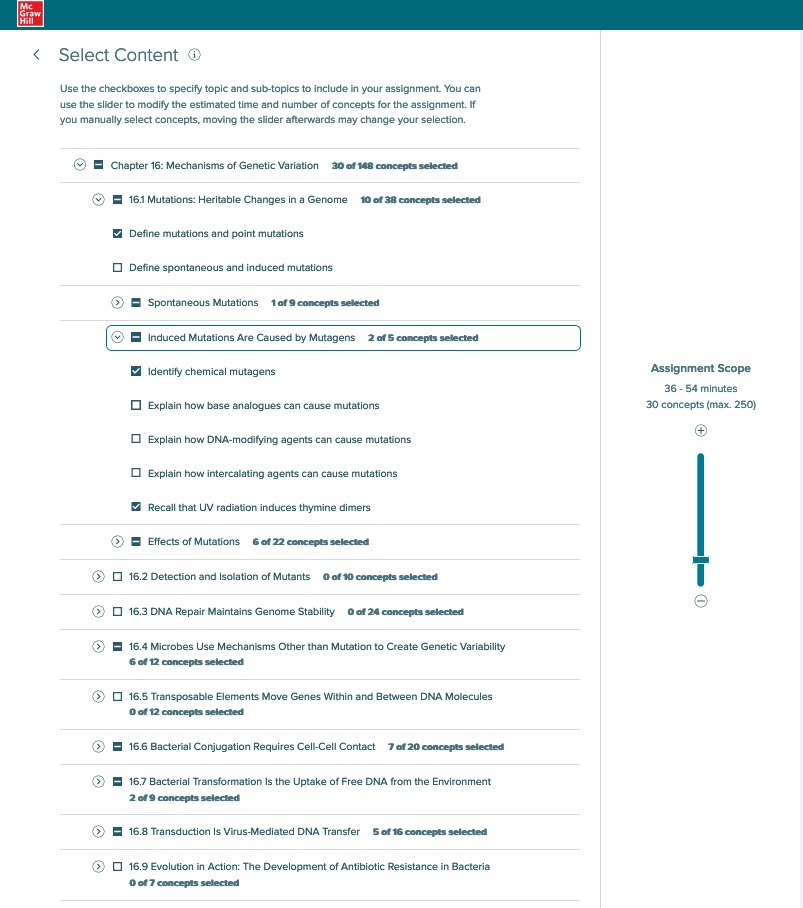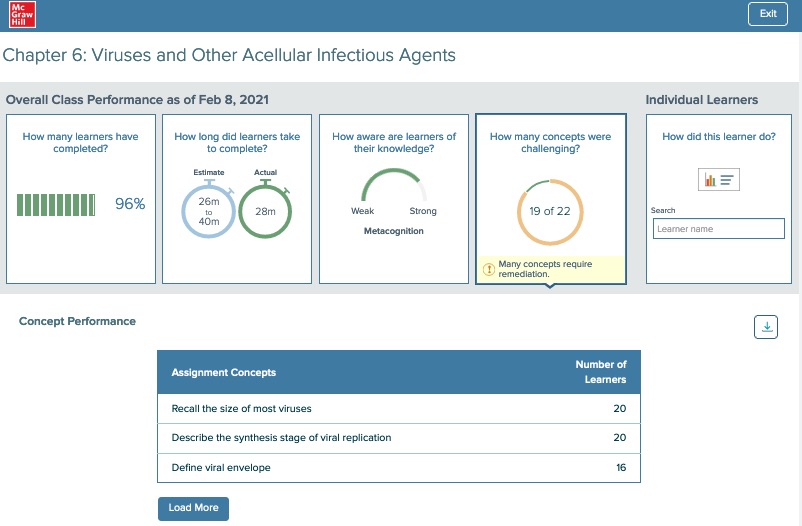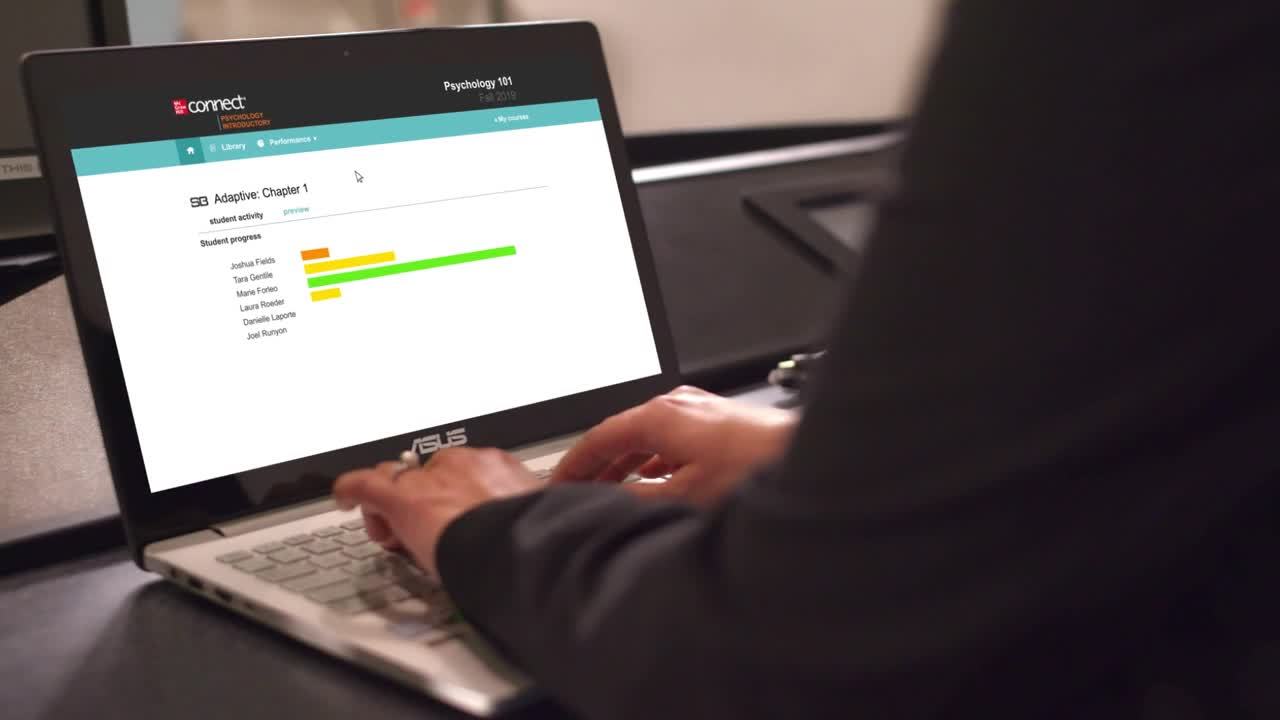How SmartBook 2.0 can facilitate achieving course specific objectives and help students develop effective learning strategies.
Learn more about how SmartBook 2.0 can facilitate achieving course specific objectives and help students develop effective learning strategies
Published February 10, 2021

Students are coming into microbiology courses with personal, and too often painful, understanding of the importance of studying microbiology. In the Spring of 2021, a quick survey at the start of one of my courses revealed that over a third of my students knew someone that had died from COVID-19. Regardless of their motivation or desire to learn about microbiology, it doesn’t change the fact that students come into 2-year and 4-year programs with a spectrum of learning skills. Many students, quite frankly, are entering microbiology courses without skills required to successfully complete the course let alone matriculate into advances programs. I have observed this across a spectrum of microbiology courses with different pre-professional objectives (pre-nursing to pre-medicine). While the demand for pre-professional programs requiring microbiology continues to be strong, it is the “pre” designation that is often part of the challenge. Students may like the topic, but often see the course as an obstacle to professional goals and not an opportunity to prepare them to be successful for those programs. How do we guide them to an understanding of the important content, and see a challenging class as an opportunity to develop learning skills that will support them as they matriculate through their academic careers?
To quickly address a common proposed solution, demanding additional pre-requisites is often a non-starter when degree programs are so tightly packed. I would also argue this is not an effective solution to meeting what I define as two primary objectives in my courses. The first always being effectively conveying content and concepts I prioritize in my course. The second being, guiding individual students to evidence-based strategies that enable them to achieve my primary goal (this also happens to support their broader academic objectives). Given the diversity of preparedness the latter is increasingly important to achieve the former. No small task!
I hope we all share a common goal of engaging students with relevant concepts and timely content related to microbiology. I am glad that as microbiologists, we appreciate how dynamic and diverse our field is, which is expressed in part by the content we each choose to emphasize. In regards to the second goal of teaching effective learning skills, not only is this goal increasingly more difficult given aforementioned spectrum of student readiness, but it is also something that many microbiology instructors do not have specific training to accomplish. The 21st century answer always seems to be technology, but technology is only a tool. However, tools like SmartBook have the potential to support achieving both of these difficult goals. If used properly, not only can SmartBook help make progress towards these, but I have also seen it do so in a manner that is both personal and relational regardless of class size and format.
First, it is critical to reiterate that technology is simply a tool. You can dig a hole with a shovel and a backhoe, and if given the choice, I would choose the backhoe. However, if you can’t start the machine or know how to use its levers, it just becomes an expensive seat, and worse you never make any progress towards your goal. I understand facilitating learning in students is a skill and art that many have developed over decades, but I hope the analogy is appreciated for what it is intended to convey (we are certainly not just digging holes). Further, I am the first to be suspicious of claims that technology can enhance what we do in the classroom. However, I have experienced that SmartBook enables me to be more efficient and effective in my craft if it is utilized well.
Here are a few tips I’ve learned (often from mistakes) on how to effectively integrate tools like SmartBook into my classes. These practices have certainly helped me through the current challenges.
Let students practice using tools early and in a low-stakes environment. I have given entire talks on dangerous assumptions when it comes to students and technology. Bottomline, just because they know how to swipe doesn’t mean they know how to use digital tools (let alone create an online account sometimes). Let them practice early and in a way that doesn’t negatively affect their grade. I provide a SmartBook reading assignment and a quick Connect quiz due the first day. Why? It gets them into Connect, and we can identify any registration issues early (the free-trial offered is great), and it provides some information to me about their preparedness. These first two assignments cover Chemistry and Biology concepts they should know given pre-requisite courses. As a carrot, I convert the quiz grade to a 100 if they complete it by the due date. Well worth the information I get regarding their readiness for the semester.

Take the time to personalize the content. As silly as it sounds to us, students get frustrated learning content that is not part of your course design or emphasis. If students see that SmartBook content is guiding them to concepts you emphasize in lecture and exams they will be more willing to invest in this tool. Conversely, assigning large amounts of content will quickly turn these assignments into busy work and disincentivize students to use them effectively. SmartBook gives us the power to drill down into specific concepts in chapters we want to emphasize. Take advantage of this to reinforce your course objectives and students will see the value more quickly.
Speaking of quickly – keep assignments (time) manageable.
I work to keep individual assignments between 15-30 minutes. I have found that extended assignments encourage the “just get it done” attitude and prevents them from investing in effective use of SmartBook. If I think more assignments are needed, break it up into multiple assignments, or often I simply encourage use of the self-study tool available in SmartBook. The latter I do anyway, but students are more receptive to doing extra assignments if the required assignments are more manageable.
Be explicit about how to use SmartBook early and often. Students are trained to see any assessment as a summative assessment. The idea of an incorrect answer frightens them because this has always been coupled with the consequence of a lower grade. SmartBook takes formative assessments and uses them as learning opportunities without the consequences of lowered grades. Missed questions in SmartBook guide students towards areas they need to improve. This leads to my next suggestion.
Incentivize for incorrect answers? Why, because without students’ honest efforts, neither they nor you benefit fully from this tool. I am explicit in saying that looking-up each SmartBook question before answering is not effective for them or me. They don’t get the guidance SmartBook provides them based on metacognitive inputs, nor do I get the data on what concepts their class needs extra time discussing in class. Show them the data! I put SmartBook data from the reporting dashboard up on the screen in class or online. I make sure to spend some time elaborating on frequently missed concepts. This allows them to see I am using the information they are providing me. Doing this early is a powerful lesson that will pay dividends later in the semester.

SmartBook supports demonstrated effective learning strategies, so show them. Repeated formative assessments are effective at building connections that persist beyond the exam. Metacognitive research has supported this through numerous studies. I like to pull an example and present it day 1. I think it is also important to point out that if they understand the content, SmartBook assessments don’t take much time (aka it’s not busy work!). However, if they need to know what they need to focus on, SmartBook guides them to these areas quickly. Couple this with SmartBook’s ability to allow me to selectively assign concepts within a chapter, and I can assure them this is an effective use of their time.
SmartBook assignments really provide a foundation that enables the exciting and challenging aspects of learning. I often say that knowing vocabulary words does not mean I can speak a particular language. I ask them if in-class time should be used to repeat vocabulary words or discuss and practice the synthesis needed to effectively speak a language. Show them Bloom’s Taxonomy, and ask if their future career expects them to operate at levels 1 and 2 or 3-6? Then follow that up with asking if they would they like my help with level 1 (recall) or 2 and above (understanding, application, etc.) in class? Most students recognize the added value I am trying to provide by using in-class time for higher level objectives.
Use technology to make personal connections. This is done at the class-level by showing and supporting concepts that are class specific using SmartBook reports, but these reports can also help you efficiently identify struggling students. Quickly reach out to them and provide a short personal word of encouragement or offer help. I have learned not to under-estimate these gestures, particularly early in the semester. If a student comes to office hours and just wants to discuss how they are struggling, SmartBook enables me to quickly give them personalized and concrete examples. This makes this time both more personal and effective. Students, don’t often know what they don’t know, but SmartBook can support me in asking questions to quickly identify their gaps in understanding.
SmartBook has helped me not only convey content I am passionate about, but also guide students to better, “learn how to learn.” While I would like to think content is the primary goal, with the dynamic nature of our field and the career trajectory of many of my students, I would argue that the latter is equally significant.
Final suggestion. It takes time to figure out how to use these tools effectively in your unique classes. Be patient, but don’t be afraid to ask for help. Take advantage of your MH implementation specialist (DFC) to help you explore strategies that fit your unique courses.

